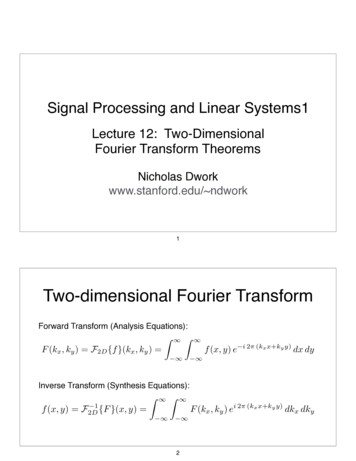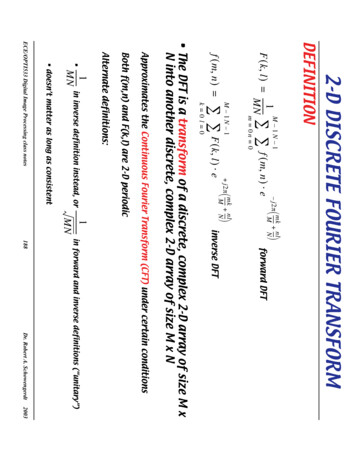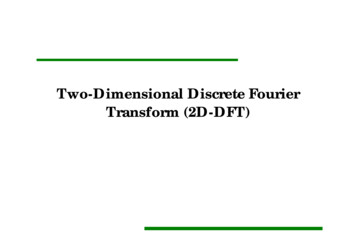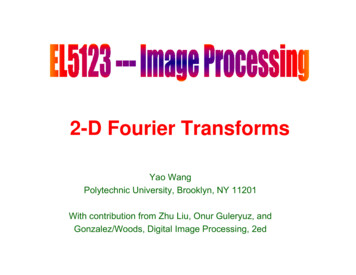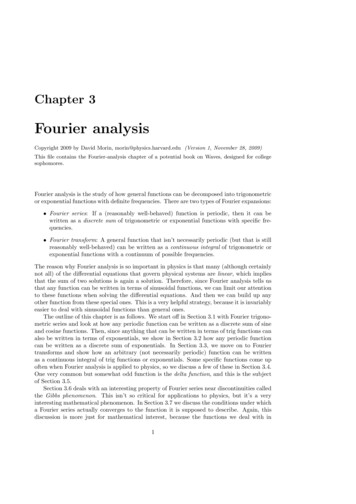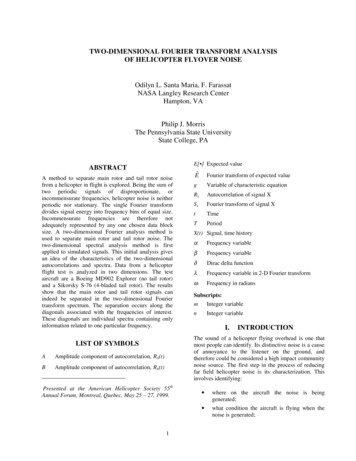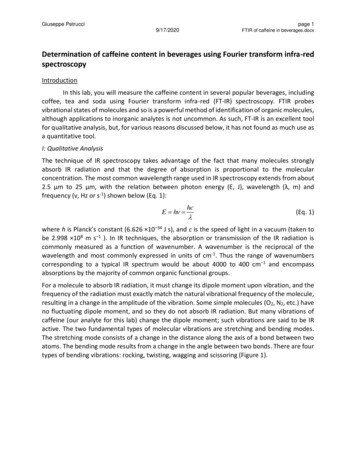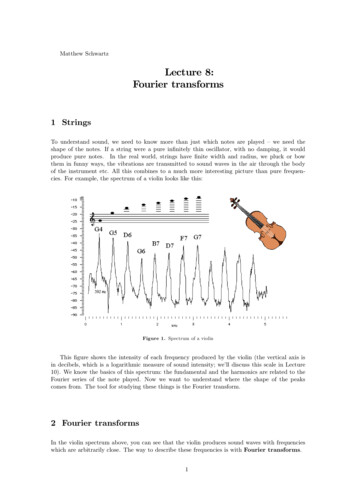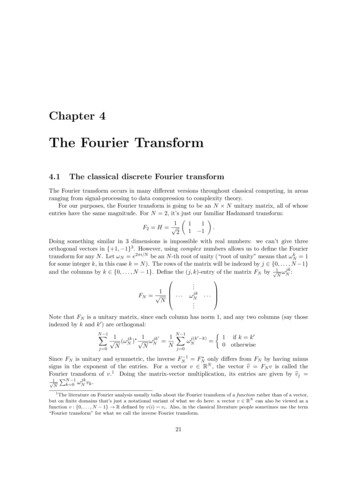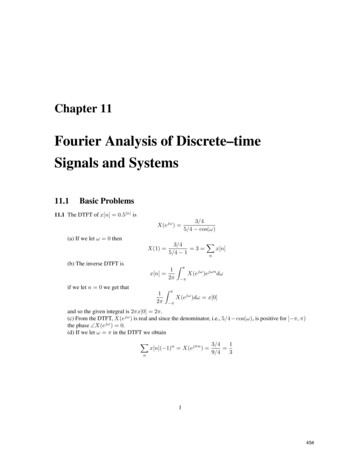
Transcription
Chapter 11Fourier Analysis of Discrete–timeSignals and Systems11.1Basic Problems11.1 The DTFT of x[n] 0.5 n isX(ejω ) (a) If we let ω 0 thenX3/4 3 x[n]5/4 1nX(1) (b) The inverse DTFT is1x[n] 2πif we let n 0 we get that12π3/45/4 cos(ω)ZZπX(ejω )ejωn dω ππX(ejω )dω x[0] πand so the given integral is 2πx[0] 2π.(c) From the DTFT, X(ejω ) is real and since the denominator, i.e., 5/4 cos(ω), is positive for [ π, π)the phase X(ejω ) 0.(d) If we let ω π in the DTFT we obtainXx[n]( 1)n X(ejπn ) n3/41 9/431454
Chaparro — Signals and Systems using MATLAB11.211.2(a) We havei. DTFTX(ejω ) 2Xe jωn 1 2 cos(ω) 2 cos(2ω)n 2ii. Z-transformX(z) z 2 z 1 z 1 z 2ROC z 0jωROC includes UCX(e ) X(z) z ejωwhich coincides with the previous result.P2iii. X(ej0 ) n 2 1 5(b) Problem 2(b)We haveX(z) 0Xαn z n n Xm 0α m z m 1, ROC: z α1 z/αso ROC must include the unit circle (UC) and as such α 1.(c) Problem 2(c)i. Z-transformsX1 (z) nX1n 0X2 (z) 2z n z1 11 0.5zz 0.5 z 0.5 1 n XX1zz n 2m z m 1 2z 0.5n m 0 z 0.5ii. Since the ROC X1 (z) includes the UC then X1 (ejω ) X1 (z) z ejω .Copyright 2014, Elsevier, Inc. All rights reserved.455
Chaparro — Signals and Systems using MATLAB11.311.3 Writingt[n] 2X(3 k )δ[n k] 3δ[n] k 22X(3 k)(δ[n k] δ[n k])k 1Ak 3 k , for 2 k 2, 0 otherwise.The Z-transform of t[n] isT (z) 3 2X(3 k)(z k z k )k 1so that the DTFT isjωT (e ) 3 2X(3 k)[ejωk e jωk ]k 1 {z}3 B0for k 2, Bk 0.2Xk 12(3 k) cos(kω) {z }BkCopyright 2014, Elsevier, Inc. All rights reserved.456
Chaparro — Signals and Systems using MATLAB11.411.4(a) Impulse response1h[n] 2πZπ/2ejωndω π/2 0.5n 0sin(πn/2)/(πn) n 6 0h[n] is non-causal as h[n] 6 0 for n 0.(b) Y (ejω ) X(ejω )H(ejω ) H(ejω ) so y[n] h[n](c) Yes, H(ejω ) H(ejω )H(ejω ) so h[n] (h h)[n].Copyright 2014, Elsevier, Inc. All rights reserved.457
Chaparro — Signals and Systems using MATLAB11.511.5(a) The DTFT of x[n] ejθ δ[n τ ] e jθ δ[n τ ] isX(ejω ) ejθ ejωτ e jθ e jωτ 2 cos(ωτ θ)by duality (ω n, τ ω0 )mistake (cf table): exp(-j theta) delta(omega omega 0) . cos(nω0 θ) π ejθ δ(ω ω0 ) e jθ δ(ω ω0 )For θ 0cos(nω0 ) π [δ(ω ω0 ) δ(ω ω0 )]For θ π/2minus-sign missing: cos(n omega 0 pi/2) -sin(n omega 0)cos(nω0 π/2) sin(nω0 ) π [jδ(ω ω0 ) jδ(ω ω0 )](b) Replacing DTFT of cosine termsjωX1 (e ) 2πδ(ω) 5Xk 1Ak π[ejθk δ(ω kω0 ) e jθk δ(ω kω0 )]Copyright 2014, Elsevier, Inc. All rights reserved.458
Chaparro — Signals and Systems using MATLAB11.611.6(a) We haveh1 [n] h[n](1 ejπn ) h[n] h[n]ejπn 2h[n] n even0otherwisesoH1 (ejω ) H(ejω ) H(ej(ω π) )thus since H(ejω ) corresponds to a LPF then H1 (ejω ) is a band-eliminating filter. Sketch itsfrequency response to verify it.(b)i. Using DTFTH(ej0 ) Xn h[n] 0.75 31.25 1ii. Using IDTFTh[ n] Z πZ π11H(ejω )e jωn dω H(e jω )e jωn dω2π π2π πZ π001H(ejω )ejω n dω 0 h[n]2π πwhere ω 0 ω.iii. The denominator 1.25 cos(ω) of H(ejω ) is positive for ( π, π], so H(ejω ) is real andpositive, with zero phase.Copyright 2014, Elsevier, Inc. All rights reserved.459
Chaparro — Signals and Systems using MATLAB11.711.7(a) (a) (b) DTFTX(ejω ) 1 e j2ω 2je jω sin(ω)Yes, X(ejω ) is periodic of period 2π since ω 2kπ ω. X(ejω ) 2 sin(ω) is periodic of X(ejω ) ππω X(ejω ) ππωFigure 11.1: Problem 7: Magnitude and phase of X(ejω )period π, but also periodic of period 2π.(b) Phase X(ejω ) ω π/2if sin(ω) 0 ω 3π/2 ω π/2 if sin(ω) 0and because of the odd symmetry of the phase it is zero at ω 0. See Fig. 11.1.Copyright 2014, Elsevier, Inc. All rights reserved.460
Chaparro — Signals and Systems using MATLAB11.911.9(a) If Ĥ(ejω ) A[u(ω ω0 ) u(ω ω0 )] with zero phase. To determine A and ω0 find the impulseresponseZAA ω0 jωne dω ĥ[n] sin(ωo n)2π ω0πnso ω0 π/3 and A 1 and since h[n] ĥ[n 10] we haveH(ejω ) e j10ω Ĥ(ejω ) e j10ω [u(ω π/3) u(ω π/3)]so the magnitude and phase responses are 1 π/3 ω π/3jω H(e ) 0 otherwise in π ω π H(ejω ) 10ω π ω π(b) X(ejω ) e jω πδ(ω π/5) πδ(ω π/5) thenY (ejω ) X(ejω )H(ejω )H(ejω )e jω πH(e jπ/5 )δ(ω π/5) πH(ejπ/5 )δ(ω π/5)H(ejω )e jω πej10π/5 δ(ω π/5) πe j10π/5 δ(ω π/5)H(ejω )e jω πδ(ω π/5) πδ(ω π/5)andy[n] h[n 1] cos(πn/5) n Copyright 2014, Elsevier, Inc. All rights reserved.462
Chaparro — Signals and Systems using MATLAB11.1011.10(a) The Z-transform1 z β 1 βz 1X(z) So when β 1 the region of convergence does not include the unit circle so the DTFT X(ejω )cannot be found. If β 1, the ROC includes the UC andX(ejω ) X(z) z ejω(b) We havei. The inverse is1x[n] 2πii. The inverse isx1 [n] 12πZZπδ(ω)ejωn dω ππ πδ(ω π)ejωn dω 12π( 1)n2πiii. δ(ω) δ( ω) so x2 [n] 2x[n] 1/π.(c) Yes, cross-multiplying(1 e jω · · · e jω(N 1) )(1 e jω ) 1 e jωNwhen N 1 we get an identity, 1 (1 e jω )/(1 e jω ).Copyright 2014, Elsevier, Inc. All rights reserved.463
Chaparro — Signals and Systems using MATLAB11.1111.11(a) Frequency responsee jω(1 2 cos(ω))31 2 cos(ω) H(ejω ) 3 ω1 2 cos(ω) 0 H(ejω ) ω π 1 2 cos(ω) 0H(ejω ) (b) Poles and zerosz2 z 1(z 0.5)2 3/4 3z 23z 2 Poles: z 0 double, zeros: z1,2 0.5 j 3/2H(z) the poles are at the origin and the zeros on the unit circle ( z1,2 1. The ROC is the wholeZ–plane except for z 0.(c) If 1 2 cos(ω0 ) 0, then the magnitude is zero and this happens at ω0 cos 1 ( 0.5)(d) Because the zeros are on the unit circle the difference between discontinuities in the wrappedphase is not 2π, so unwrapping would not change the phase.Copyright 2014, Elsevier, Inc. All rights reserved.464
Chaparro — Signals and Systems using MATLAB11.1211.12(a) Frequency responseH(ejω ) e j2ω (1.2 cos(ω)) H(ejω ) 2ω linear, as 1.2 cos(ω) 0 ω ( π, π](b) Impulse responseH(z) {z}0.5 z 1 {z}1.2 z 2 {z}0.5 z 3h[1]h[2]h[3]h[n] is symmetric with respect to n 2, so the phase is linear.Copyright 2014, Elsevier, Inc. All rights reserved.465
Chaparro — Signals and Systems using MATLAB 11.11 11.11 (a) Frequency response H(e. j!) e. j! 3 (1 2cos(!)) jH(e. j!)j 1 2cos(!) 3 \H(e. j!) ˆ! 1 2cos(!) 0! ˇ 1 2cos(!) 0 (b) Poles and zeros H(z) z. 2 z 1 3z. 2 (z 0:5) 2 3 4 3z. 2. Poles: z 0 double; zeros: z. 1;2 0:5 j p 3 2 the poles are at the origin and the .
